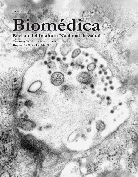Susceptibility of different Rhodnius species (Hemiptera, Reduviidae, Triatominae) to a Brazilian strain of Trypanosoma rangeli (SC58/KP1-)
Abstract
Introduction: Specific host-parasite associations have been detected experimentally and suggest that triatomines of the genus Rhodnius act as biological filters in the transmission of Trypanosoma rangeli.
Objective: To analyze the susceptibility of four Rhodnius species (Rhodnius robustus, Rhodnius neglectus, Rhodnius nasutus and Rhodnius pictipes) to a Brazilian strain of T. rangeli (SC-58/KP1-).
Materials and methods: We selected thirty nymphs of each species, which were fed on blood infected with T. rangeli. Periodically, samples of feces and hemolymph were analyzed. Triatomines with T. rangeli in their hemolymph were fed on mice to check for transmission by bites. Later, the triatomines were dissected to confirm salivary gland infection.
Results: Specimens of R. pictipes showed higher rates of intestinal infection compared to the other three species. Epimastigotes and trypomastigotes were detected in hemolymph of four species; however, parasitism was lower in the species of the R. robustus lineage. Rhodnius robustus and R. neglectus specimens did not transmit T. rangeli by bite; after dissection, their glands were not infected. Only one specimen of R. nasutus and two of R. pictipes transmitted the parasite by bite. The rate of salivary gland infection was 16% for R. pictipes and 4% for R. nasutus.
Conclusions: Both infectivity (intestinal, hemolymphatic and glandular) and transmission of T. rangeli (SC58/KP1-) were greater and more efficient in R. pictipes. These results reinforce the hypothesis that these triatomines may act as biological filters in the transmission of T. rangeli.
Downloads
Some similar items:
- Diana Carolina López, Carlos Jaramillo, Felipe Guhl, Population structure and genetic variability of Rhodnius prolixus (Hemiptera: Reduviidae) from different geographic areas of Colombia. , Biomedica: Vol. 27 No. 1esp (2007): Enfermedad de Chagas
- Andrea Arévalo, Julio César Carranza, Felipe Guhl, Jairo A. Clavijo, Gustavo Adolfo Vallejo, Comparison of feeding and defecation patterns of Rhodnius colombiensis and Rhodnius prolixus (Hemiptera, Reduviidae, Triatominae) under laboratory conditions. , Biomedica: Vol. 27 No. 1esp (2007): Enfermedad de Chagas
- Gustavo Adolfo Vallejo, Felipe Guhl, Julio César Carranza, Omar Triana, Gerardo Pérez, Paola Andrea Ortiz, Dairo Humberto Marín, Lina Marcela Villa, Jazmín Suárez, Isaura Pilar Sánchez, Ximena Pulido, Ingrid Bibiana Rodríguez, Leyder Elena Lozano, Daniel Alfonso Urrea, Fredy Arvey Rivera, César Cuba-Cuba, Jairo Alfonso Clavijo, Trypanosoma rangeli parasite-vector-vertebrate interactions and their relationship to the systematics and epidemiology of American trypanosomiasis , Biomedica: Vol. 27 No. 1esp (2007): Enfermedad de Chagas
- Andrea Arévalo, Julio César Carranza, Felipe Guhl, Jairo Alfonso Clavijo, Gustavo Adolfo Vallejo, Comparison of the life cycles of Rhodnius colombiensis Moreno, Jurberg & Galvão, 1999 and R. prolixus Stal, 1872 (Hemiptera, Reduviidae, Triatominae) under laboratory conditions , Biomedica: Vol. 27 No. 1esp (2007): Enfermedad de Chagas
- Andrea Arévalo, Julio César Carranza, Felipe Guhl, Gustavo Adolfo Vallejo, Electrophoretic patterns of salivary hemeproteins (nitrophorines) of Rhodnius colombiensis and R. prolixus (Hemiptera, Reduviidae, Triatominae) , Biomedica: Vol. 27 No. 1esp (2007): Enfermedad de Chagas
- Lorenzo Cáceres, José R. Rovira, José Calzada, Azael Saldaña, Evaluation of the toxic activity of the pyrethroid insecticides deltamethrin and lambdacyhalothrin in two Panamanian field populations of Rhodnius pallescens (Hemíptera: Reduviidae) , Biomedica: Vol. 31 No. 1 (2011)
- Víctor Manuel Angulo, Lyda Esteban, Katherine Paola Luna, Attalea butyracea palms adjacent to housing as a source of infestation by Rhodnius prolixus (Hemiptera: Reduviidae) , Biomedica: Vol. 32 No. 2 (2012)
- Camilo Rubio, Ligia Inés Moncada, Marco Andrés Rojas, Alexander García, Feeding behavior of Rhodnius robustus Larouse, 1927 (Hemiptera, Reduviidae) under laboratory conditions , Biomedica: Vol. 33 No. 2 (2013)
- Víctor Manuel Angulo, Lyda Esteban, Plutarco Urbano, Eduwin Hincapié, Luis Alberto Núñez, Comparison of methods for the capture of triatomines (Hemiptera: Reduviidae) in Attalea butyracea palms in the Eastern Plains of Colombia , Biomedica: Vol. 33 No. 4 (2013)
- Carmen Vásquez, Sara Robledo, Jaime Calle, Omar Triana, Identification of new epidemiological scenarios for Chagas disease in the Momposina region, North of Colombia , Biomedica: Vol. 33 No. 4 (2013)
| Article metrics | |
|---|---|
| Abstract views | |
| Galley vies | |
| PDF Views | |
| HTML views | |
| Other views | |


























